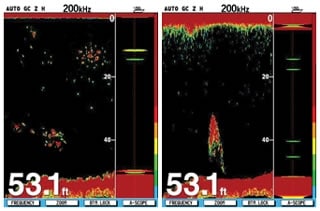
| To compare the performance of Raymarine’s DSM250 (left) with that of a typical analog fishfinder (right), simply look at the definition of targets in the image. The user can discern individual fish, rather than just the location of the school, and with good surface and bottom definition. |
Raymarine is introducing the DSM250, a “black box” fishfinder hook-up to its HSB2 series of products that represents a significant leap beyond the technology that has dominated the fishfinder field for the past 50 years. Basically, it’s a tremendous advance in digital technology – so much so that the company is patenting the hardware that lies at the heart of the unit. The unit, smaller than a cigar box, hooks up to any of the Raymarine Plus displays, LCD or CRT, color or monochrome, and works with both seven- and ten-inch screens.
We recently had a chance to test the new sounder, and found it impressive, to say the least. How it works is interesting, but more to the point, what you see on the display screen has a lot to do with locating and catching fish. What became evident is that this sounder presents information as a serious fisherman would like to have it displayed.
The display we viewed as we cruised the holes and ledges off Fort Lauderdale was amazingly clear and free of clutter. It was sharp and bright in full sunlight, and it looked like the image had been scrubbed of all nonessential information. Surface clutter was non-existent, which allowed us to see fish holding near the surface that are often lost in the mass of color and echo return created by wave action, wind, current or weeds. Secondly, bottom detail was outstanding, well defined and clear of extraneous return. The DSM250 is nearly devoid of the kind of unnecessary information you’d otherwise have to learn to interpret.
Lastly and most importantly, was the image of fish, at all depths. Definition here was dramatic. If you are accustomed to seeing an inverted “V” that indicates a small bunch of fish, you quickly get spoiled with the DSM250, as it shows you six or eight clearly defined individual fish. It takes a lot of the guesswork out of interpreting the fishfinder display.
After an hour of playing with the machine, it no longer appeared so remarkable – it simply seemed like the way a fishfinder should work. The best part, the DSM250 made all the necessary adjustments to achieve these results automatically. No need to fiddle with any controls.
What’s different about the DSM250 compared to current fishfinders on the market? Traditional fishfinders use fixed analog filters in their receivers. These filters receive the soundwaves or echoes from the transducer, then send the echo to the processor to be displayed. The limitation here is that the analog filters are fixed at one setting, which means at certain depths the receiver works at peak performance. Everything else deeper and shallower is a compromise. At the heart of this revolutionary Raymarine system is a digital adaptive receiver. This receiver contains a digital filter with an onboard processor (or brain), which can digitally adjust the value required by the receiver to provide peak reception of the echo, as well as control the output power of the transmitter, at any depth in any sea condition. Imagine having a receiver with thousands of filters, which instantaneously react to each signal return individually – thousands of times a second. This dynamic adaptive receiver is the big news here, and it is the technology being patented.
The DSM250, of course, has the usual adjustments and customization features you’d expect. The unit is ready to roll and easy to use right out of the box, so you can simply install it and go fishing. It integrates with Raytech 4.1 software and the entire Raymarine HSB2 system. The DSM250 is priced at $780, with display screen and optional software sold separately. Raymarine, Nashua, NH; (800) 539-5539; www.raymarine.com.- Glenn Law

Click here to buy Raymarine products. |









